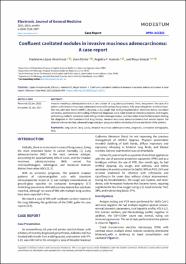Mostrar el registro sencillo del ítem
“Confluent cavitated nodules in invasive mucinous adenocarcinoma: A case report“
| dc.contributor.author | López-Hinostroza, Madaleine | |
| dc.contributor.author | Dávila, Juan | |
| dc.contributor.author | Asencio, Angélica Y. | |
| dc.contributor.author | Moya-Salazar, Jeel | |
| dc.date.accessioned | 2023-09-06T21:36:01Z | |
| dc.date.available | 2023-09-06T21:36:01Z | |
| dc.date.issued | 2023-06-20 | |
| dc.identifier.uri | https://hdl.handle.net/20.500.13053/9246 | |
| dc.description.abstract | Invasive mucinous adenocarcinoma is a rare variant of lung adenocarcinoma. Here, we present the case of a patient with invasive mucinous adenocarcinoma with cavitary lung lesions. A 61-year-old painter-and-bricklayer. She was admitted due to mMRC2 dyspnea, a dry cough that during hospitalization mobilizes dense, abundant secretions, and becomes demanding. Differential diagnoses were made based on clinical symptoms and images, performing multiple laboratory tests ruling out immunosuppression, and two video-bronchofibroscopies finding the diagnosis in the transbronchial lung biopsy: Invasive mucinous adenocarcinoma that would explain the abundant bronchorrhea, advanced stage and poor prognosis led to ventilatory failure and death of the patient | es_PE |
| dc.format | application/pdf | es_PE |
| dc.language.iso | eng | es_PE |
| dc.publisher | Modestum LTD | es_PE |
| dc.rights | info:eu-repo/semantics/openAccess | es_PE |
| dc.rights.uri | https://creativecommons.org/licenses/by/4.0/ | es_PE |
| dc.subject | lung cancer, lung cavity, invasive mucinous adenocarcinoma, prognosis, computed tomography, Peru | es_PE |
| dc.title | “Confluent cavitated nodules in invasive mucinous adenocarcinoma: A case report“ | es_PE |
| dc.type | info:eu-repo/semantics/article | es_PE |
| dc.identifier.doi | 10.29333/ejgm/13151 | |
| dc.type.version | info:eu-repo/semantics/publishedVersion | es_PE |
| dc.publisher.country | GBR | es_PE |
| dc.subject.ocde | 3.03.00 -- Ciencias de la salud | es_PE |
Ficheros en el ítem
Este ítem aparece en la(s) siguiente(s) colección(es)
-
SCOPUS [380]


